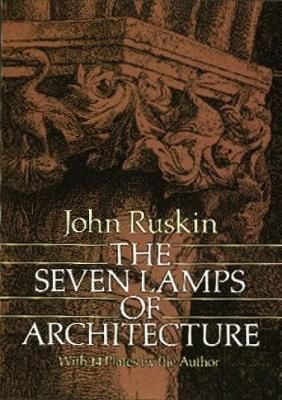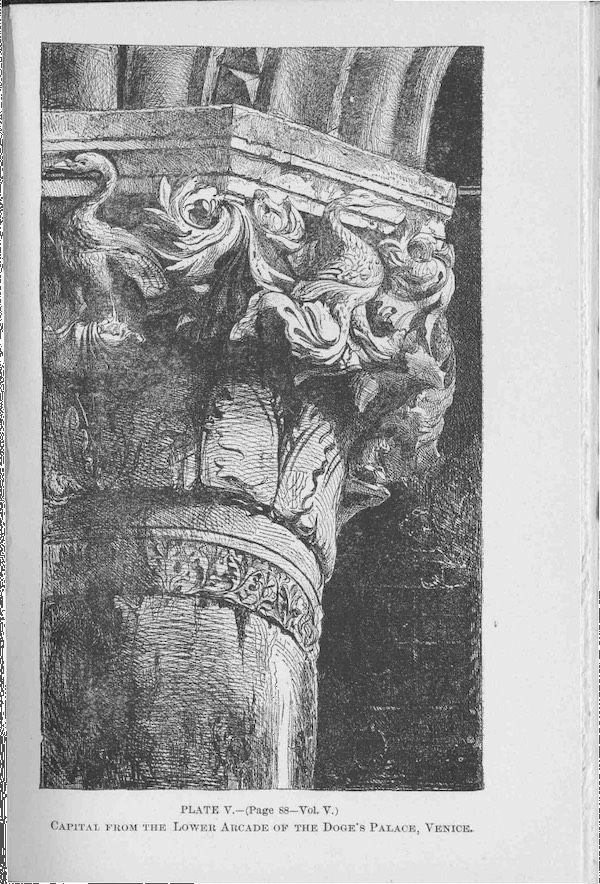The Seven Lamps of Architecture Book Review and Notes

A review of The Seven Lamps of Architecture by John Ruskin an influential book and author that is a hard slog but might be rewarding.
Background
John Ruskin art and architecture and social critic. He was born in London in 1819 and died in 1900 so his life runs alongside Queen Victorias reign and he fairly neatly sits within the Victorian era. Much of the thinking and aesthetics of that time can be seen through his writing and indeed was hugely influenced by it. In his early career for instance his support of the pre-raphelites, the romantic and gothic revivals of the time, the appreciation of nature and rebellion against increasing mechanisation and market capitalism marks him out as a leading thinker of the time.

Ruskin comes from a world so different from our own now, changing from an agrarian class based society to one where market capitalism and the industrial revolution were starting to change the world. The baby steps of Science in Geology and Biology blew away comfortable religious views.
He starts out as an outsider and brave critic by championing a modern way of painting through his support of William Turner for example. However later in his life also increasingly beset by mental illness he seems not to be able to accommodate new thinking or differing views, see his court case with the artist James Whistler . His influence is huge though, within art of all types at the time and also in social policy, influencing emerging politicians into the 20th Century. Ghandi, Beveriidge, William Morris, Proust and Tolsty were all deeply influenced by him just to name a few.
‘Unto This Last’, I translated it later into Gujarati entitling it ‘Sarvodaya’ (the welfare of all). I believe that I discovered some of my deepest convictions reflected in this great book of Ruskin and that is why it so captured me and made me transform my life. — Mahatma Gandhi

Introduction
The Seven Lamps of Architecture is Ruskins first work about Architecture under his own name. First published in 1849 and later revised in a Travellers’ Edition in 1879 it came out before his opus on Architecture the three volume Stones of Venice.
Outline
The title The Seven Lamps of Architecture prefers to what Ruskin identifies as Seven guiding principles in the forming of good Architecture. They are lamps guiding you on a course rather than straightjackets and it’s a good metaphor and apt in Ruskin’s worldview.
Sacrifice
Ruskin spends some time at the beginning defining the difference between Architecture and Building. Architecture that in the building which goes beyond its immediate use.
But if these projecting masses be carved beneath into rounded courses, which are useless, and if the headings of the intervals be arched and trefoiled, which is useless, that is Architecture.
He then says there are five categories of Architecture; Devotional, Memorial, Civil, Military and Domestic.
Good Architecture comes at a price, it is hard and as much effort as possible should be put into it. If you are going to build a building it should be the absolute best that you can afford! Not to a budget but to your best endeavours and the people who worked on the building should have given it their upmost effort.
Truth
Buildings should be true or honest to themselves. That they shouldn’t pretend to have other functions or be more expensive than they are.
But in architecture another and a less subtle, more contemptible, violation of truth is possible; a direct falsity of assertion respecting the nature of material, or the quantity of labor.
They should be true to their materials, a thin facade of Marble infront of a cheap brick wall is considered a deceit by Ruskin.
Also Ruskin hates machine of manufactured work. Handwork and hand craft is more truthful
There are two reasons, both weighty, against this practice; one, that all cast and machine work is bad, as work; the other, that it is dishonest.
Power
A sublime building is a mix between the lamps of Beauty and Power. Inspiring with its force or beauty or mix of the two. A good building that is larger should be less decorated and vice versa. Proportion of the building is important.
Beauty
True beauty is inspired by nature and so all elements of good Architecture flow in some way from the natural.
It will be thought that I have somewhat rashly limited the elements of architectural beauty to imitative forms. I do not mean to assert that every arrangement of line is directly suggested by a natural object; but that all beautiful lines are adaptations of those which are commonest in the external creation; that in proportion to the richness of their association, the resemblance to natural work, as a type and help, must be more closely attempted, and more clearly seen; and that beyond a certain point, and that a very low one, man cannot advance in the invention of beauty, without directly imitating natural form.
Ruskin does not like inscriptions and text on his buildings, and ornamentation should be separate from the business or function of the building, it has higher purposes. Ruskin believes that Architecture is its own ‘form of creation’ within the world, that it doesn’t just house a function or represent an abstract set of ideals.
I would only note one point, that sculpture is the representation of an idea, while architecture is itself a real thing.
Life
Handcrafted always is better than machine made. Life is put into a detail because of its small imperfections, an experienced workman puts a little of his experience and life into his work and that reflected on the building with an aesthetic and moral force. This informs also his social outlook, there is an inherent dignity to all work for Ruskin.
Memory
Good buildings reference and respect their predecessors and the national and local styles. Any innovation should be built onto of these foundations.
And if indeed there be any profit in our knowledge of the past, or any joy in the thought of being remembered hereafter, which can give strength to present exertion, or patience to present endurance, there are two duties respecting national architecture whose importance it is impossible to overrate; the first, to render the architecture of the day historical; and, the second, to preserve, as the most precious of inheritances, that of past ages.
He is skeptical of restoration, maintenance is fine but where you restore by adding or recreating this is akin to lying.
Do not let us talk then of restoration. The thing is a Lie from beginning to end.
Sometimes a building has had its time;
It is a necessity for destruction. Accept it as such, pull the building down, throw its stones into neglected corners, make ballast of them, or mortar, if you will; but do it honestly, and do not set up a Lie in their place.
Obedience
Once or twice in doing this, I have named a principle to which I would now assign a definite place among those which direct that embodiment; the last place, not only as that to which its own humility would incline, but rather as belonging to it in the aspect of the crowning grace of all the rest; that principle, I mean, to which Polity owes its stability, Life its happiness, Faith its acceptance, Creation its continuance,—Obedience.
So Obedience is almost most important to Ruskin. He means that buildings are not innovative. They should align to the national and then local style and should not be divorced from that. Architects should be original in much less fundamental ways.
Originality in expression does not depend on invention of new words; nor originality in poetry on invention of new measures; nor, in painting, on invention of new colors, or new modes of using them.

Overview
The Seven Lamps itself proports to be analytical, but Ruskins taste is too subjective and whimsical. Ruskin is long winded, the sentences go on forever, it’s hard work to follow the points as stretched out as they mostly are. It’s also imbued with a pius religiosity which can be grating and hardly supports any claim of objectivity.
But the The Seven Lamps contains the foundations of an aesthetic, moral and social critique of the division of labour and industrial capitalism which is further fleshed out in The Stones of Venice. Inside its pages there is always something beautiful, sometimes profound and engaging if you have the patience to find it. There is always the possibility to get lost in the beautiful sketchs and description of details and feel there really is something profound to be found among them.
Conclusion
Ruskin never really talks about the utility of the buildings or their purpose or how they locate in the city. But;
In his works on art, Ruskin tackles the relationship between the role of consciousness and the unconscious, the individual and society. I would argue he comes close to a dialectical understanding of art. He regards the aesthetic impact of an image as a measure of its truthfulness (“Nothing can be beautiful that is not true”), but sets it within its sociological context (“Every noble form of architecture is in some sort the embodiment of the Polity, Life, History and Religious Faith of nations”). Although the artist should be true to Nature, the “most fiery passion and most original thought” of the individual artist is crucial. It is only when a work “stands forth with its solemn ‘Behold It is I’” that “the work becomes art indeed”. - The contradictory legacy of John Ruskin’s artistic and social critique - World Socialist Web Site
Late Victorian architecture became such a potpourri of styles and confections, in some ways the meaning of classical architecture had been lost in Ruskins lifetime decades before the onset of International Modernism in the early twentieth century. As Ruskins’ mind deserted him perhaps also he felt that the moral anchor in art had been lost to the next generation. He retired from society to his home Brantwood.
However you feel about his project I think there is always time to come read, look at his art anf learn something from his views even if the world is different.
The book is a fairly difficult read with rewards if you are willing to dig deep. The kindle version I bought had no illustrations so I would recommend buying a paperback or downloading the Gutenberg version for free. There is a a lot to love about the illustrations and the general outlook of the book which is inclusive and rich.